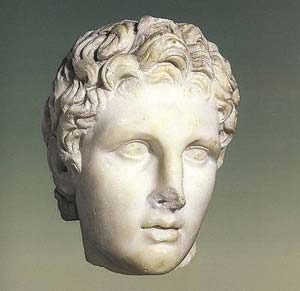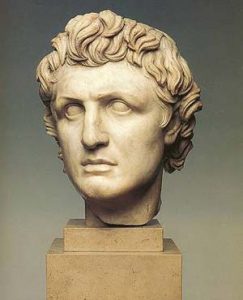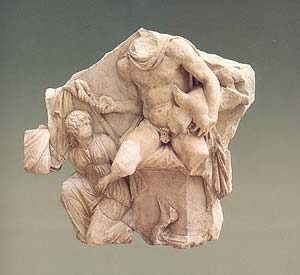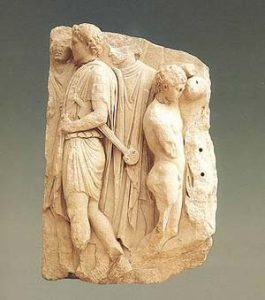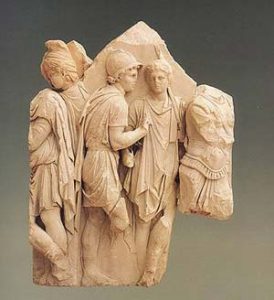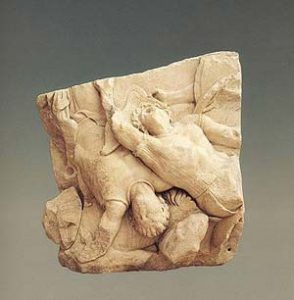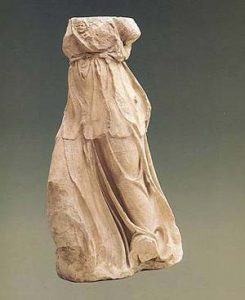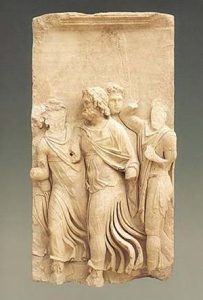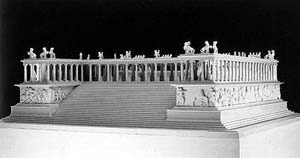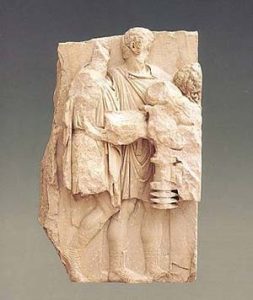Pergamon Altar: Telephus Frieze
Promoted by the Fine Arts Museums of San Francisco and the Metropolitan Museum of Art of New York,
in collaboration with the Antikensammlung Berlin, Staatliche Museen zu Berlin – Preussischer Kulturbesitz and the Municipality of Rome
October 05 1996 / January 15 1997
Roma – Palazzo Ruspoli (80.690 visitors)
Catalogue – Leonardo Arte
- Testa di un giovane
- Testa di principe ellenistico
- Telefo minaccia il piccolo Oreste
- Telefo giunge presso gli Argivi
- Telefo riceve le armi da Auge
- Nella battaglia del fiume Caico
- Statuetta di Atena
- Il re Teutrante trova Auge sulla spiaggia
- Modello dell’Altare di Pergamo
- Hiera caduta in battaglia viene composta sul letto di morte
The exhibition “Pergamon Altar: Telephus Frieze” presents for the first time in Italy the marbles of the II century b.C. coming from the big Pergamon Altar, considered the more spectacular monument of the hellenistic world.
An exceptional event for his uniqueness and for the huge artistic and historical value of the exposed materials. The reliefs on display are part of the monumental frieze that tells the history of the mythical hero Telephus, the legendary progenitor of the Attalid dynasty, who reigned over Pergamum in the Hellenistic period.
After the first finding of the remains of the altar, happened in 1886, the German archaeological excavations in the city of Pergamum in Asia Minor (on the north-west coast of current Turkey), started regularly in 1878, continued, except short interruption, until today and continue.
All the reliefs and the architectural part of the Altar were transported to Berlin where they were partially recomposed in 1901. The rebuilt Altar was exposed since 1930 in the new “Pergamon Museum” in Berlin, located in the eastern area of the city and therefore difficult to visit.
Two years ago, the 51 reliefs of the Telephus Frieze were detached again, studied, cleaned and restored with the most modern techniques that returned the marbles their original splendour.
The Metropolitan Museum of Art and Fine Art Museums of San Francisco contributed to the restoration and to show 12 among the most spectacular reliefs of the Frieze through a travelling exhibition before they were permanently reinstalled in Berlin.
After its previous stops in New York and San Francisco, the exhibition is now in Rome, hosted by Fondazione Memmo at Palazzo Ruspoli for just three months before its final return to Germany.
The Roman chapter of the tour, unique in Italy and unpostponable, was made possible thanks to the kind cooperation of the Antikensammlung Staatliche zu Berlin – Preussischer Kulturbesitz, which delayed the return to Germany and the planned relocation of the Telephus reliefs in the museum. Special thanks also go to The Metropolitan Museum of Art and the Fine Arts Museums of San Francisco, the organizers of the exhibition, and the essential collaboration of the Superintendent of Cultural Heritage of the City of Rome.
Objects exposed in the exhibition:
12 slabs with the high reliefs of Telephus Frieze
Statues and figurative fragments
Figurative fragments of the Gigantomachy
Architectural fragments of the Altar
Votive inscription of the Altar
Coins
The Prometheus group
Scale model 1:20 of the Big Altar.
All the archeological material exposed were excavated in Pergamum and are dated to the II century b.C; in addition to the Telephus reliefs, fragments of the frieze with gigantomachy and architectural fragments of the Altar are also exhibited.
A rare collection of coin with effigies of Attalid king next to marble portraits of King Attalo I, a room dedicated to one of the most important dynasties of the Hellenistic era.
The new scale model of the Big Altar 1:20, faithful in every detail, collects the results of recent studies and therefore presents notable innovations and interpretations regarding the shape of the Altar and the arrangement of some slabs of friezes.
Pergamum was located on the north-western Asia Minor coast, current Turkey, and was the most important city, with Alexandria of Egypt, of the Hellenistic culture and then capital of the roman Asian province.
In Pergamum, which became independent after the death of Alexander the Great in 323 b.C., Attalus I proclaimed himself king, starting the Attalid dynasty, the most important of the Hellenistic period. The city knew 3 centuries of great economic prosperity which favored an incredible artistic and cultural flourishing. The Attalids king, like the Ptolemies in Alexandria and the Selucidi in Antiochia with their building activity transformed Pergamum into one of the grandest and most splendid cities of the Hellenistic world.
It was the center of a great artistic production and the only city where it’s possible to have a complete picture of Hellenistic art without interruption. The architecture of the city, its sculptures, and its artistic school have shaped our conception of late Greek art.
Pergamum was famous in the whole ancient world also for the extraordinary library of over 20.000 volumes and for the medical research center and hospital. After the death of the last king Attalo III, the reign was annexed to the Roman Republic and Rome chose Pergamum as the capital of the province of Asia. With the advent of Christianity, Pergamon became one of the first Christian communities.
In fact, the church of Pergamon, mentioned in the Apocalypse is one of the seven centers where Christians laid the foundations of the ecclesiastical organization.
The Big Altar
The Big Altar, one of the 7 wonders of the word, was the most imposing and spectacular monument of Pergamum and maybe of the entire Hellenistic world.
It is certain that the altar was built by the Attalid kings to celebrate their victory over the Galatians and as a thank you for having spread the importance of Pergamum over much of western Asia Minor.
Thought the narratives of the two friezes, the Attalid kings who present themselves as custodians of the Greek legacy, are also exalted and glorified.
The Altar stood halfway up the hill, on the ascent towards the Acropolis. Its dimensions were 36 meters by 34 meters. Placed on a tall pedestal adorned on three sides with a splendid and extensive high-relief frieze (120 meters in length and 23 meters in height), depicting a Gigantomachy (the battle between the Olympian gods and the Giants for the conquest of the sky), it consisted of a large colonnaded enclosure open to the west, accessed by an imposing staircase and two side porticos. The Gigantomachy was the largest frieze, another smaller but equally beautiful one adorned the inner perimeter wall of the upper colonnade and depicted episodes from the life of Telephus, the son of Heracles and the mythical founder of Pergamon.

